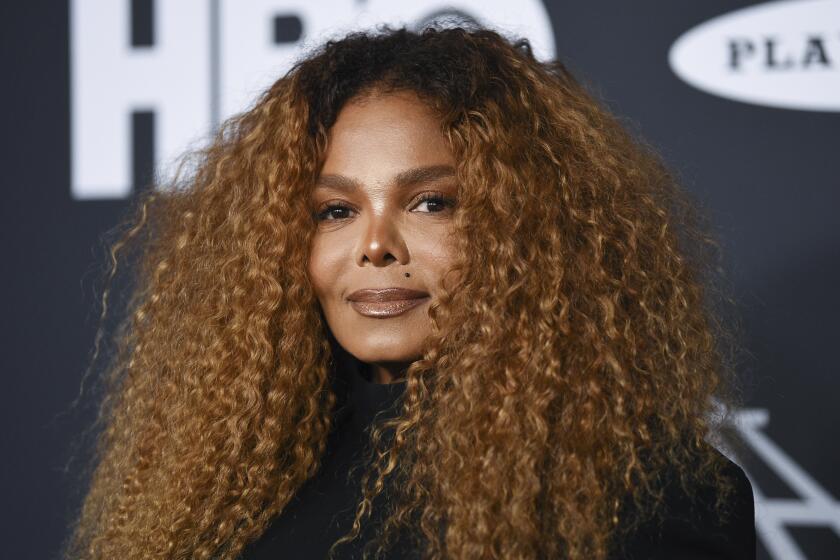Ken Burns turns to ‘Country Music’ for his next PBS docuseries
There was a moment, however fleeting, when documentary filmmaker Ken Burns thought a change of pace might be in order as he was wrapping up more than a decade of often emotionally draining, logistically nightmarish work on his 10-part, 18-hour exploration of the complex history and bitter legacy of the Vietnam War.
A colleague piqued his interest when he suggested country music. Burns thought it might fill the bill, but he worried that it might be too lightweight a subject.
“It seemed that this could be a frivolous agenda,” Burns, 65, said by phone earlier this week from his Florentine Films office in Walpole, N.H., where he and his team were putting the finishing touches on “Country Music,” an eight-part, 16½-hour series scheduled to premiere Sept. 15 on PBS.
“It’s not. It’s as elemental, and in fact, there were more tears shed by warm bodies in the editing room for this than for ‘Vietnam.’”
The project promises to offer a deep exploration into the genre. Burns theorizes that through country music, we can get a better understanding of the American experience.
“All these elemental things — birth, death, falling in love, falling out of love, seeking redemption and erring and all the things human flesh is heir to — that’s the stuff country music is about,” said Burns, who collaborated with writer-producer Dayton Duncan and producer Julie Dunfey.
“What we’ve done over the last eight years is to tear away the undergrowth and look at this magnificent stuff as a new way of focusing on America, seeing race, seeing people who think their stories aren’t being told. It’s all a good story to tell and a good story to tell now.”
He’s referring to the groundswell of Americans disenchanted with the political process, as reflected in the results of the 2016 and 2018 elections, and how that feeling is mirrored in the story of country music, which was born as an expression of people and subjects largely ignored by other styles popular in urban areas.
“It’s the Mark Twain school of history — that idea attributed to him that ‘history doesn’t repeat itself, but it rhymes,’” Burns said. “We agree with it. We just proceed working with our films and trying to master the story, but it never surprises me when we look up and find that they are speaking to the moment.”
Many of the contemporary musicians interviewed for the project will take part in an all-star concert March 27 at the Ryman Auditorium in Nashville, widely known as the “Mother Church of Country Music”; it’s also the longtime home of the influential Grand Ole Opry revues and radio broadcasts. That concert, for which Burns and Dayton worked closely with Sally Williams, SVP and GM of the Ryman and the Grand Ole Opry, will be filmed and broadcast in the fall in conjunction with the film series itself.
In many respects, the new series will reflect the signature Burns style: slow pans across, in and out of historical photos, vintage film and video footage, on-camera interviews, exhaustive historical research and even-handed narration by actor Peter Coyote.
In this case, as with his 10-part, 19-hour “Jazz” series in 2001, “Country Music” also incorporates dozens of musical performances plus archival and new interviews with key musical figures. They reflect on music that has roots reaching back hundreds of years to antecedents in Europe and Africa, illustrating the genre’s evolution up through the predetermined historical cutoff point of 1996.
While producer Duncan notes that they interviewed Bill Malone, who Duncan calls “the patriarch of country music historians,” the series puts a heavy emphasis on artist insights. Marty Stuart, for instance, figures prominently, as, in the words of Duncan, “we discovered we didn’t need to go [extensively] to historians who were an arm’s length away to bring this story to life.”

“Rosanne Cash [Johnny Cash’s daughter] also knows a lot about it, is passionate and articulate about it and also is able to see the big picture,” adds Duncan. “So are Vince Gill, Ricky Skaggs, Emmylou Harris and many others. We decided we don’t really have to necessarily find a lot of historians. For our storytelling, we’ve got the material we need from these people, and that gives it a little different flavor.”
Veteran songwriter, singer and multi-instrumentalist Stuart, who got his start as a teenage prodigy hired by bluegrass pioneer Lester Flatt, is well-known in country circles as an obsessive historian, collector and cataloger of country’s history.
“Ken and his team really understand how to educate and entertain at the same time,” Stuart, 60, said in another interview. “A few years ago, my wife, Connie [Smith, a longtime country star in her own right], said she heard Ken Burns say he was thinking about doing something on country music. I sat down and wrote him and Dayton a fan letter, because I was always a fan of their work. About three months later, I wound up meeting with them.”
Burns and Duncan said they conducted 175 hours of interviews with 101 subjects — noting that roughly 20% of them have since died. They’ve also incorporate 3,200 photographs and hours of archival film footage.
Stuart cited four key elements in the series that he finds most rewarding.
“They found evidence of Jimmie Rodgers film footage and photographs that the world has never seen,” he said of the early 20th century singer, songwriter and recording star from Meridian, Miss., regarded as the “Father of Country Music.” “To me, that’s worth the price of admission alone. There’s never been a proper documentary on Jimmie Rodgers. The Carter Family, yes, but now we have a proper documentary on Jimmie Rodgers.”
Other aspects he singled out include the way the filmmakers “have done a better job giving proper credit to women’s role in country music, and the lasting effect they’ve had on the genre.”
Likewise, the influence of African Americans in country music is brought into sharper relief. Many a monumental country figure was mentored by or collaborated with African American artists — see Hank Williams and blues singer-guitarist Rufus “Tee Tot” Payne or A.P. Carter and guitarist Lesley Riddle. Additionally, some of Rodgers’ influential early recordings also feature jazz titan Louis Armstrong prominently.
Burns himself will team with New Orleans jazz musician Wynton Marsalis for an April 25 program in New York as part of the Jazz at Lincoln Center series that Marsalis oversees. It will preview the “Country Music” film and feature performances of songs spotlighted in the series.
Further, rising roots music star Rhiannon Giddens of the Carolina Chocolate Drops is among the younger generation musicians interviewed. Giddens speaks from her deep knowledge of the crucial role that African American string band music played in the early development of country music.
The significance of Burns taking on country music hasn’t been lost in Nashville.
“Ken and Dayton are such amazing storytellers,” said the Grand Ole Opry and Ryman Auditorium’s Sally Williams. “With this documentary, they’re telling the story of one of the greatest storytelling mechanisms we know, and that is the country song.”
The series spans more than a century of music history, and also touches on various regional centers beyond Nashville, examining the California country wing with Buck Owens, Merle Haggard and dozens of others, and country’s Texas contingent, with such superstars as Willie Nelson, Waylon Jennings, George Jones and Kris Kristofferson.
It also folds in revered but lesser known singer-songwriters such as Guy Clark and Townes Van Zandt and references various regions in the South that gave rise to Rodgers, Hank Williams, Patsy Cline, Loretta Lynn, Dolly Parton and Tammy Wynette.
“One of the things I love about this project is that it is so multi-dimensional,” Sally Williams said.
That reflects the discovery process that was as much a part of the creation of the series at it promises to be in the final film.
“One of the themes of ours is that country music isn’t, and never was, just one style of music,” said Duncan, an amateur musician who noted that the song he chose for his first public performance at age 8 in a Quaker church in rural Iowa was Marty Robbins’ 1957 country-pop crossover hit “A White Sport Coat (and a Pink Carnation).”
“It’s been a mixture of hymns and blues and minstrel songs and work songs and sentimental songs and old work songs from the British Isles,” Duncan said. “It never did congeal into any one thing. It came from many roots and then started its own branches.”
All concerned are ready for whatever criticisms may be thrown their way about artists or events viewers may think were overlooked or underplayed.
“We’re not an encyclopedia,” Burns said. “We’re not a dictionary, and yes, we’re probably going to miss something in your favorite decade. We probably had a great scene on it, but in the merciless triage of editing, ultimately, it was left out because there were too many words.”
That reality should be partially assuaged by the more extensive companion book Duncan is writing for publication around the time the series premieres.
“We’re into communicating to a broad national audience without dumbing down a broad story that’s very complicated,” Burns said. “I always feel great when anybody came up to me and said, ‘You know what you left out of ‘Baseball’ or ‘The Civil War’? That means they watched 16 or 18 hours and were pissed because I left something out.”
Burns credited PBS for its support for his work since his first effort, the 1981 film “Brooklyn Bridge.” Although there are far more outlets today for ambitious documentaries, such as Netflix and HBO, Burns said he wouldn’t think of jumping ship.
“This doesn’t happen without public broadcasting,” he said. “I couldn’t have made any of my films without PBS. Yes, I could go to a streaming service or cable channel today, but who would give me $30 million and 10½ years to do ‘Vietnam’? Nobody else would have permitted that.
“That’s why I’ve stayed there against all the other lucrative stuff available today,” he said. “There are no suits around saying, ‘Make it shorter, make it longer, make it more sexy, less sexy, more violent or less violent.’ We get to print our director’s cut every time.”
Follow @RandyLewis2 on Twitter.com
For Classic Rock coverage, join us on Facebook
More to Read
The biggest entertainment stories
Get our big stories about Hollywood, film, television, music, arts, culture and more right in your inbox as soon as they publish.
You may occasionally receive promotional content from the Los Angeles Times.










